| Listing 1 - 10 of 18 | << page >> |
Sort by
|
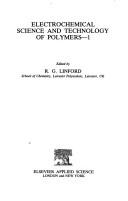
ISBN: 1851660313 9781851660315 Year: 1987 Volume: I Publisher: London New York Elsevier Applied Science
Abstract | Keywords | Export | Availability | Bookmark
 Loading...
Loading...Choose an application
- Reference Manager
- EndNote
- RefWorks (Direct export to RefWorks)
Polymers --- Electric properties --- Polymers - Electric properties

ISBN: 0792314034 940105536X 9401134766 9780792314035 Year: 1991 Publisher: Dordrecht Kluwer
Abstract | Keywords | Export | Availability | Bookmark
 Loading...
Loading...Choose an application
- Reference Manager
- EndNote
- RefWorks (Direct export to RefWorks)
fysicochemie --- Macromolecules --- Polymers --- Electric properties --- Congresses. --- Polymers - Electric properties - Congresses.
Book
Year: 1997
Abstract | Keywords | Export | Availability | Bookmark
 Loading...
Loading...Choose an application
- Reference Manager
- EndNote
- RefWorks (Direct export to RefWorks)
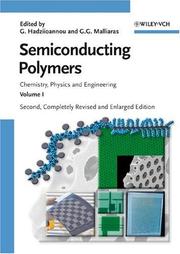
ISBN: 9783527312719 3527312714 Year: 2007 Publisher: Weinheim Wiley
Abstract | Keywords | Export | Availability | Bookmark
 Loading...
Loading...Choose an application
- Reference Manager
- EndNote
- RefWorks (Direct export to RefWorks)
Electronics and optics of solids --- Organic semiconductors --- Polymers --- Semiconductor doping --- Electronics --- Electric properties --- Optical properties --- Materials --- Polymers - Electric properties --- Polymers - Optical properties --- Electronics - Materials
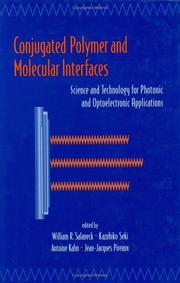
ISBN: 0824705882 9780824705886 Year: 2002 Publisher: New York (N.Y.) Dekker
Abstract | Keywords | Export | Availability | Bookmark
 Loading...
Loading...Choose an application
- Reference Manager
- EndNote
- RefWorks (Direct export to RefWorks)
Photonics --- Polymers --- Optoelectronic devices --- Materials --- Electric properties --- -Photonics --- -Polymers --- -Polymere --- Polymeride --- Polymers and polymerization --- Macromolecules --- New optics --- Optics --- Photo electric devices --- Photo electronic devices --- Photoelectronic devices --- Electronic apparatus and appliances --- Optical instruments --- Electrooptical devices --- Integrated optics --- -Materials --- Photonics - Materials --- Polymers - Electric properties --- Optoelectronic devices - Materials --- Photonic devices --- Photonic instruments
Book
ISBN: 9786612085956 1282085956 1847351468 1615831215 9781847351463 9781615831210 9781847351456 184735145X Year: 2008 Publisher: Shawbury, Shrewsbury, Shropshire, U.K. ISmithers
Abstract | Keywords | Export | Availability | Bookmark
 Loading...
Loading...Choose an application
- Reference Manager
- EndNote
- RefWorks (Direct export to RefWorks)
This Update covers all aspects of electrospinning as used to produce Nanofibres. It contains an array of colour diagrams, mathematical models, equations and detailed references.Electrospinning is the cheapest and the most straightforward way to produce nanomaterials. Electrospun Nanofibres are very important for the scientific and economic revival of developing countries. It is now possible to produce a low-cost, high-value, high-strength fibre from a biodegradable and renewable waste product for easing environmental concerns.For example, electrospun nanofibres can be used in wound dressings,
Nanofibers. --- Electrospinning. --- Nanostructured materials. --- Textile fibers, Synthetic. --- Polymers --- Artificial fibers --- Synthetic fibers --- Synthetic textile fibers --- Polyesters --- Synthetic fabrics --- Synthetic products --- Synthetic fibers industry --- Nanomaterials --- Nanometer materials --- Nanophase materials --- Nanostructure controlled materials --- Nanostructure materials --- Ultra-fine microstructure materials --- Microstructure --- Nanotechnology --- Spinning --- Fibers --- Nanostructured materials --- Electric properties. --- Textile fibers, Synthetic --- Nanofibers --- Electrospinning --- Electric properties --- Polymers - Electric properties
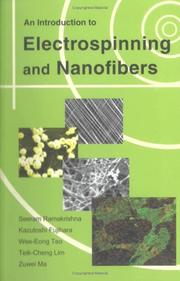
ISBN: 1281880752 9786611880750 9812567615 9789812567611 9789812564153 9812564152 9789812564542 9812564543 9781281880758 Year: 2005 Publisher: Singapore Hackensack, NJ World Scientific
Abstract | Keywords | Export | Availability | Bookmark
 Loading...
Loading...Choose an application
- Reference Manager
- EndNote
- RefWorks (Direct export to RefWorks)
The research and development of nanofibers has gained much prominence in recent years due to the heightened awareness of its potential applications in the medical, engineering and defense fields. Among the most successful methods for producing nanofibers is the electrospinning process. In this timely book, the areas of electrospinning and nanofibers are covered for the first time in a single volume.The book can be broadly divided into two parts: the first comprises descriptions of the electrospinning process and modeling to obtain nanofibers while the second describes the characteristi
Textile fibers, Synthetic. --- Polymers --- Nanostructured materials. --- Artificial fibers --- Synthetic fibers --- Synthetic textile fibers --- Polyesters --- Synthetic fabrics --- Synthetic products --- Synthetic fibers industry --- Nanomaterials --- Nanometer materials --- Nanophase materials --- Nanostructure controlled materials --- Nanostructure materials --- Ultra-fine microstructure materials --- Microstructure --- Nanotechnology --- Electric properties. --- Textile fibers, Synthetic --- Polymers - Electric properties --- Nanostructured materials --- Electro spinning. --- Electrospinning. --- Nanofibers.
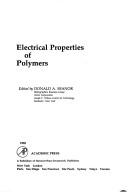
ISBN: 0126336806 1322290806 1483220125 9780126336801 Year: 1982 Publisher: New York, N.Y. Academic Press
Abstract | Keywords | Export | Availability | Bookmark
 Loading...
Loading...Choose an application
- Reference Manager
- EndNote
- RefWorks (Direct export to RefWorks)
fysicochemie --- Dielectrics of solids --- Macromolecules --- Polymers --- Polymères --- Electric properties --- Propriétés électriques --- 678.01:537 --- -Polymere --- Polymeride --- Polymers and polymerization --- Properties. Defects. Constitution. Serviceability. Sampling. Analysis. Testing-:-Electricity. Magnetism. Electromagnetism --- -Properties. Defects. Constitution. Serviceability. Sampling. Analysis. Testing-:-Electricity. Magnetism. Electromagnetism --- -678.01:537 Properties. Defects. Constitution. Serviceability. Sampling. Analysis. Testing-:-Electricity. Magnetism. Electromagnetism --- Polymere --- 678.01:537 Properties. Defects. Constitution. Serviceability. Sampling. Analysis. Testing-:-Electricity. Magnetism. Electromagnetism --- Polymères --- Propriétés électriques --- Electric conductivity. --- Polymers - Electric properties --- Dielectric properties --- Photochemistry
Book
ISSN: 00653195 ISBN: 354057476X 038757476X 3540481923 9783540574767 Year: 1994 Volume: 115 Publisher: Berlin Springer
Abstract | Keywords | Export | Availability | Bookmark
 Loading...
Loading...Choose an application
- Reference Manager
- EndNote
- RefWorks (Direct export to RefWorks)
fysicochemie --- Macromolecules --- Polymers --- Photoconductivity --- Electric properties --- 678.01:541.14 --- 678.046.34 --- -Photoconductivity --- Electric conductivity --- Photoelectricity --- Photoresistors --- Polymere --- Polymeride --- Polymers and polymerization --- Properties. Defects. Constitution. Serviceability. Sampling. Analysis. Testing-:-Photochemistry --- Industries based on macromolecular materials. Rubber industry. Plastics industry--?.046.34 --- Photoconductivity. --- Electric properties. --- 678.046.34 Industries based on macromolecular materials. Rubber industry. Plastics industry--?.046.34 --- 678.01:541.14 Properties. Defects. Constitution. Serviceability. Sampling. Analysis. Testing-:-Photochemistry --- Polymers - Electric properties --- PHOTOCONDUCTIVITY --- POLYMERS --- METALS, COMPOUNDS --- POLYMERIZATION --- PROPERTIES
Book
ISBN: 1489985514 1461408776 9786613705099 1280794704 1461408784 Year: 2012 Publisher: New York : Springer,
Abstract | Keywords | Export | Availability | Bookmark
 Loading...
Loading...Choose an application
- Reference Manager
- EndNote
- RefWorks (Direct export to RefWorks)
Electroactivity in Polymeric Materials provides an in-depth view of the theory of electroactivity and explores exactly how and why various electroactive phenomena occur. The book explains the theory behind electroactive bending (including ion-polymer-metal-composites –IPMCs), dielectric elastomers, electroactive contraction, and electroactive contraction-expansion cycles. The book also balances theory with applications – how electroactivity can be used – drawing inspiration from the manmade mechanical world and the natural world around us. This book captures: A complete introduction to electroactive materials including examples and recent developments The theory and applications of numerous topics like electroactive bending of dielectric elastomers and electroactive contraction and expansion New topics, such as biomimetic applications and energy harvesting This is a must-read within the electroactive community, particularly for professionals and graduate students who are interested in the fundamental understanding of the electroactive phenomena.
Polymers -- Electric properties. --- Polymers -- Measurement. --- Polymers. --- Chemistry --- Health & Biological Sciences --- Physical Sciences & Mathematics --- Organic Chemistry --- Biomedical Engineering --- Electric insulators and insulation --- Polymere --- Polymeride --- Polymers and polymerization --- Engineering. --- Biomedical engineering. --- Optical materials. --- Electronic materials. --- Biomaterials. --- Biomedical Engineering. --- Polymer Sciences. --- Optical and Electronic Materials. --- Macromolecules --- Polymers --- Biomedical Engineering and Bioengineering. --- Optics --- Materials --- Clinical engineering --- Medical engineering --- Bioengineering --- Biophysics --- Engineering --- Medicine --- Biocompatible materials --- Biomaterials --- Medical materials --- Biomedical engineering --- Biocompatibility --- Prosthesis --- Polymers . --- Bioartificial materials --- Hemocompatible materials --- Electronic materials --- Biomaterials (Biomedical materials)
| Listing 1 - 10 of 18 | << page >> |
Sort by
|

 Search
Search Feedback
Feedback About UniCat
About UniCat  Help
Help News
News